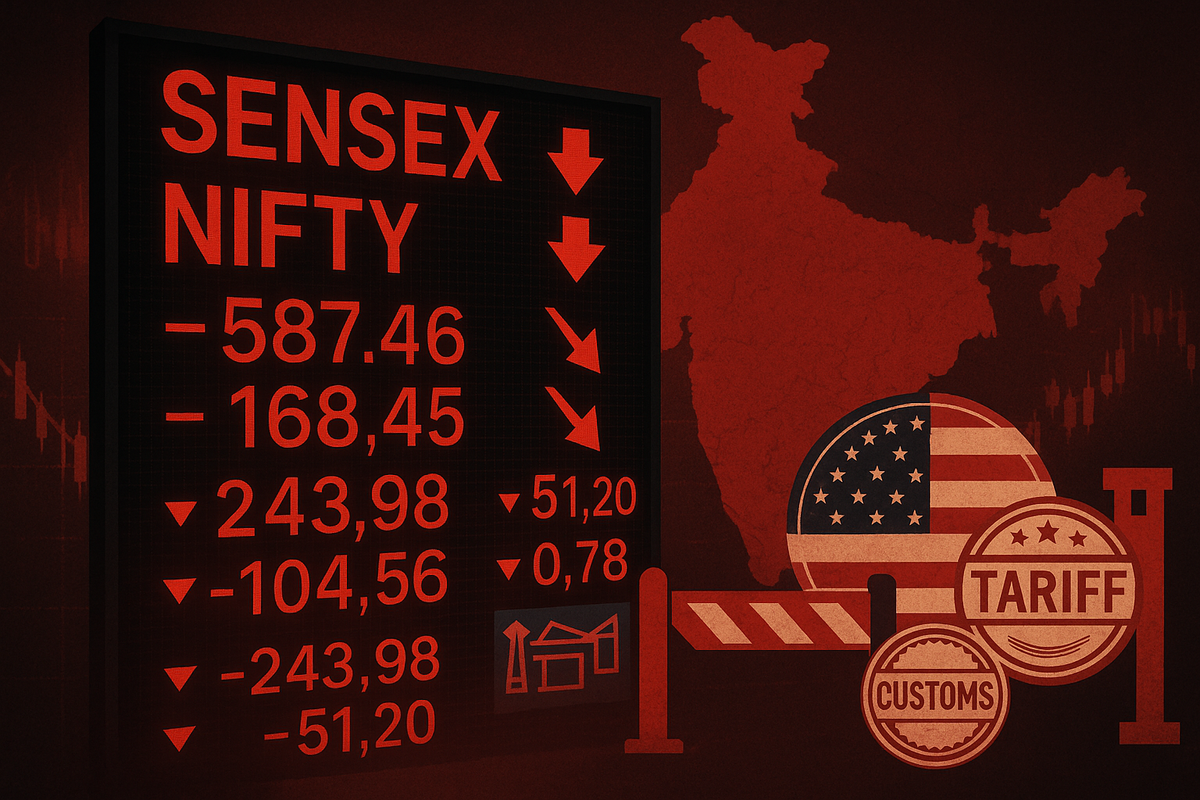
The Indian stock market is currently grappling with a severe downturn, as both the benchmark Sensex and Nifty indices are poised for their sixth consecutive weekly loss. This prolonged slump, the longest since the COVID-19 induced crash of April 2020, signals significant market distress and has wiped out substantial investor wealth. The primary catalyst for this sharp decline is the recent imposition of new, higher tariffs by the United States on Indian goods, exacerbating existing market vulnerabilities.
This sustained bearish sentiment reflects growing concerns among investors regarding the economic implications of the escalating trade tensions. The immediate aftermath of the tariff announcement saw a sharp sell-off across various sectors, with export-oriented industries bearing the brunt of the impact. The confluence of geopolitical pressures, persistent foreign institutional investor outflows, and subdued domestic corporate earnings has created a challenging environment for Indian equities, leaving market participants bracing for further volatility.
US Tariffs Ignite Market Sell-Off: A Deep Dive into India's Economic Headwinds
The recent turmoil in the Indian stock market can be directly attributed to a significant policy shift from the United States. On August 6, 2025, U.S. President Donald Trump announced an additional 25% tariff on Indian goods, elevating the total tariff rate on Indian exports to a staggering 50%. This aggressive move was presented as a retaliatory measure against India's continued procurement of Russian oil, despite Western sanctions. The 50% tariff is notably more punitive than those applied to most other Asia-Pacific nations, raising serious concerns about India's competitive standing in global trade.
The immediate fallout was palpable. On Friday, August 8, the BSE Sensex (BSE: SENSEX) plummeted by 765.47 points, or 0.95%, to close at 79,857.79. Concurrently, the NSE Nifty (NSE: NIFTY) shed 232.85 points, or 0.95%, trading at 24,363.30. This single-day decline resulted in an estimated loss of approximately ₹5 lakh crore in market capitalization for investors, underscoring the severity of the market's reaction.
Beyond the direct impact of the tariffs, several other factors have converged to amplify the market's distress. Persistent Foreign Institutional Investor (FII) outflows have been a significant drag, with foreign investors acting as net sellers for ten consecutive sessions. They have pulled over ₹15,950 crore from Indian equities in August alone, contributing to total outflows exceeding $4 billion since July. This sustained selling indicates a strategic repositioning by global investors, likely due to a perceived shift in India's risk-reward profile. Furthermore, lackluster first-quarter corporate earnings have failed to provide a much-needed buffer against increasing global pressures, further eroding investor confidence. The strengthening US dollar has also compounded the pain for the Indian market, making imports more expensive and potentially leading to inflationary pressures.
Export-Oriented Sectors Bear the Brunt: Identifying the Winners and Losers
The imposition of a 50% tariff on Indian goods by the United States has created a clear divide in the market, with export-oriented sectors facing significant headwinds while others might remain relatively insulated or even find opportunities. The most immediate and severe impact is being felt by industries heavily reliant on exports to the US, particularly those dealing in goods.
Sectors such as gems and jewelry, apparel, textiles, and chemicals are among the primary losers. Companies like Titan Company Limited (NSE: TITAN), a major player in the jewelry segment, and various textile manufacturers could see their profit margins severely squeezed as the 50% tariff makes their products uncompetitive in the crucial US market. For many businesses in these sectors, exporting to the US may become entirely unviable, potentially leading to reduced orders, production cuts, and even job losses. The research indicates that this tariff level could shrink India's GDP by as much as 1%, highlighting the broad economic ramifications for these vulnerable export segments.
Conversely, sectors with limited direct exposure to goods-based exports to the US, or those primarily serving the domestic market, are expected to be less affected, or could even emerge as relative winners. The Nifty 50, for instance, has only about 9% direct exposure to the US market, primarily concentrated in IT services. Companies like Tata Consultancy Services (NSE: TCS) and Infosys (NSE: INFY), major players in the Indian IT services sector, are largely exempt from goods-based duties, as their services are not subject to these tariffs. While broader market sentiment might still impact their stock performance, their fundamental business operations are less directly threatened by the new tariffs. Furthermore, companies focused on domestic consumption and infrastructure development might find themselves in a relatively stronger position, as their revenue streams are less dependent on international trade dynamics.
Broader Implications: India's Trade Landscape and Global Economic Shifts
The recent tariff imposition by the US on Indian goods is not an isolated event but rather fits into a broader global trend of increasing trade protectionism and geopolitical realignments. This move underscores the growing willingness of major economies to use trade as a tool for political leverage, particularly in response to perceived non-compliance with international sanctions or diplomatic stances. For India, this event highlights the vulnerabilities of its export-led growth strategy when faced with unilateral trade actions from key partners.
The ripple effects of these tariffs could extend beyond the directly impacted sectors. Competitors in other nations, not subject to such high tariffs, might gain a competitive advantage in the US market, potentially diverting orders away from Indian manufacturers. This could force Indian companies to seek new markets or re-evaluate their global supply chains, leading to significant strategic pivots. Furthermore, the tariffs could strain diplomatic relations between India and the US, potentially impacting future trade agreements, technology transfers, and strategic partnerships. From a regulatory standpoint, India may consider retaliatory tariffs or seek recourse through international trade bodies, though such actions could further escalate tensions.
Historically, trade disputes have often led to periods of market volatility and economic uncertainty. While the current situation is distinct, comparisons can be drawn to past trade wars, where tit-for-tat tariffs led to reduced global trade volumes and dampened economic growth. The prolonged losing streak of the Sensex and Nifty, the longest since the COVID-19 crash, serves as a stark reminder of how quickly external shocks can destabilize even resilient markets. This event underscores the need for India to diversify its export markets and strengthen its domestic demand to build greater resilience against such external pressures.
What Comes Next: Navigating Uncertainty and Seeking New Pathways
The immediate future for the Indian stock market appears challenging, with continued volatility expected in the short term. Investors will be closely watching for any signs of de-escalation in trade tensions between India and the US, or potential policy responses from the Indian government. In the short term, the market is likely to remain sensitive to news flow regarding trade negotiations, FII activity, and the performance of export-oriented companies. Further FII outflows could exacerbate the downturn, while any positive news on the trade front could provide a much-needed relief rally.
In the long term, Indian companies, particularly those in the affected export sectors, will need to consider strategic pivots. This could involve accelerating efforts to diversify their export markets beyond the US, focusing on emerging economies or regions with more favorable trade policies. Companies might also explore increasing their domestic market penetration to reduce reliance on international trade. For the government, potential strategic adaptations could include engaging in high-level diplomatic talks to resolve the tariff dispute, or implementing measures to support affected industries, such as production-linked incentives for domestic manufacturing or export promotion schemes for alternative markets.
Market opportunities may emerge for companies focused on import substitution or those catering to robust domestic demand. Sectors like infrastructure, renewable energy, and domestic consumption-driven industries could see increased investor interest as a hedge against global trade uncertainties. However, the overarching challenge will be to navigate the unpredictable geopolitical landscape and adapt to a potentially more fragmented global trade environment. Scenarios range from a swift resolution of the tariff dispute, leading to a market rebound, to a prolonged trade standoff that could significantly impact India's economic growth trajectory and necessitate a fundamental reorientation of its trade policies.
Conclusion: A Critical Juncture for India's Economic Resilience
The sharp decline in Indian stocks, marked by the Sensex and Nifty's sixth consecutive weekly loss, represents a critical juncture for India's economic resilience. The primary takeaway from this event is the profound impact that geopolitical tensions and unilateral trade actions can have on even large, emerging markets. The 50% tariff imposed by the US serves as a stark reminder of the interconnectedness of global economies and the vulnerabilities inherent in relying heavily on specific trade partners.
Moving forward, the Indian market will likely remain under pressure until there is greater clarity on the resolution of the trade dispute and a more stable global trade environment emerges. Investors should exercise caution, focusing on companies with strong fundamentals, diversified revenue streams, and a robust domestic presence. The event underscores the importance of a balanced portfolio, with a potential shift towards defensive sectors or those less exposed to international trade volatility.
In the coming months, investors should closely watch for any diplomatic breakthroughs between India and the US, the Indian government's policy responses to support affected industries, and the trajectory of FII flows. The ability of Indian companies to adapt their strategies, explore new markets, and innovate in the face of these challenges will be crucial in determining the long-term impact of this trade shock. Ultimately, this period of market distress will test India's economic fortitude and its capacity to navigate an increasingly complex and unpredictable global landscape.





